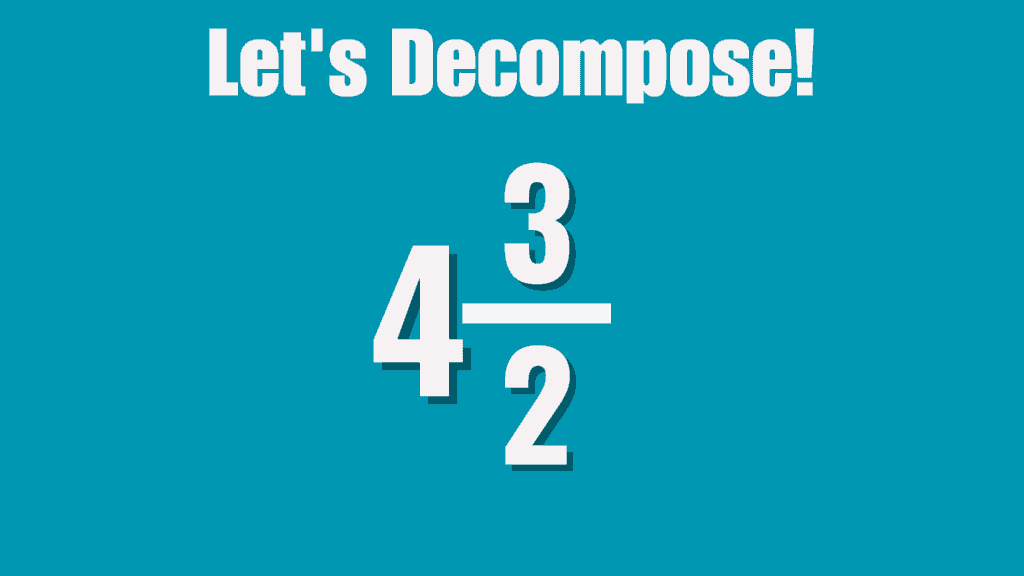Understanding fractions is a crucial skill for students, and one effective approach to mastering fractions is through decomposing. Decomposing fractions involves breaking them apart into smaller fractions. By making connections between whole numbers and fractions, students can enhance their understanding and confidently tackle fraction-related problems. In this blog post, we will explore the concept of decomposing fractions, benefits, practical examples, and strategies for effective teaching.
Watch the full video here: Decomposing Fractions: A Quick Guide for Parents and Teachers

Decomposing Whole Numbers and Fractions
To comprehend the concept of decomposing fractions, students must first recognize the relationship between whole numbers and fractions. Consider the example of the number 9 and the fraction 9/12. By decomposing 9 into a sum of 4, 4, and 1, students can apply the same principle to fractions. Therefore, the fraction 9/12 can be decomposed into the sum of 4/12, 4/12, and 1/12. This connection between whole numbers and fractions helps students grasp the concept more intuitively.

Starting with Unit Fractions
An effective starting point is to introduce unit fractions, which are fractions with a numerator of one. For instance, consider the fraction 7/10. By breaking apart seven tenths into a sum of unit fractions, students will find that the unit fraction for 7/10 is 1/10. Next, have students explore how many one-tenths they will need to combine to make up seven tenths. Just as seven ones combine to form the number seven, seven one-tenths combine to form the fraction seven tenths.

Decompose Fractions to Avoid Misconceptions
One major benefit of spending time on decomposing fractions is that it helps students avoid the misconception of adding denominators. When students view fractions as compositions of smaller parts, they build on their understanding of knowing that the numerator describes the count of pieces, while the denominator describes the size of each piece. This understanding is crucial when adding or subtracting fractions. It ensures students focus on the numerators rather than mistakenly trying to add the denominators.

Using Unit Fractions and Non-Unit Fractions to Decompose
Once students have grasped decomposing unit fractions, they can progress to non-unit fractions, which have a numerator greater than one. The same principle applies—students can combine unit fractions in various ways to represent non-unit fractions. For example, have students examine the fraction greater than one, 10/4. By breaking it apart into a sum of non-unit fractions, they’ll find multiple possible representations. Breaking apart fractions can include only unit fractions, only non-unit fractions, or a combination of both. Encourage students to explore and come up with as many ways as they can think of to decompose a fraction into a sum of fractions.

Decomposing Mixed Numbers and Whole Numbers
In addition to fractions, students should also practice decomposing mixed numbers and whole numbers. Similar to breaking down fractions into smaller parts, you can break apart whole numbers in different ways as well. For instance, they can be decomposed using only ones or rewritten as fractions equal to one. By providing students with ample opportunities to decompose mixed numbers and whole numbers, educators can strengthen students’ understanding of decomposition and its application in various scenarios.
Read Next: Easily Teach How to Adding Mixed Numbers in 3 Different Ways

Decomposing Fractions Practice Problems and Conclusion
To reinforce the skill of decomposing fractions, it is recommended that students engage in practice problems. By solving these problems themselves, students can solidify their understanding before tackling them in a formal teaching setting. Practice problems serve as a valuable tool for individual learning and can be used as a springboard for group discussions and further exploration.
The second part of the fourth grade math standard (CCSS) states that students should justify decompositions in ways such as using a visual fraction model. Students can do this by using math manipulatives such as fraction tiles, or by drawing picture models.
4.NF.B.3.b: Decompose a fraction into a sum of fractions with the same denominator in more than one way, recording each decomposition by an equation. Justify decompositions, e.g., by using a visual fraction model.


In conclusion, decomposing fractions is a powerful technique that allows students to break down complex fractions into simpler units. By establishing connections between whole numbers and fractions, students develop a deeper understanding of fractions as composed entities. Decomposing fractions not only aids in avoiding misconceptions but also enhances problem-solving abilities. By encouraging exploration during lessons and with practice problems, educators can empower students to master fractions and excel in their mathematical journey.

Give your students more opportunities to practice decomposing fractions with these practice problems: Decomposing Fractions Practice Problems

